The AFT-9 is the now ageing 4x4 ATGM armoured tank hunter using the HongJian 9 ('Red Arrow' 9) of the People's Liberation Army Ground Force. The launched were modified as to also fire anti-air missile and provided to mobile force an organic universal short range missile protection. Deceloped in the late 1980s, the ATGM was provided a platform derived from the Wz.500. Never exported, unvailed in 1990 the Norinco vehicle is only fielded by the PLA today with 450 estimated in service.
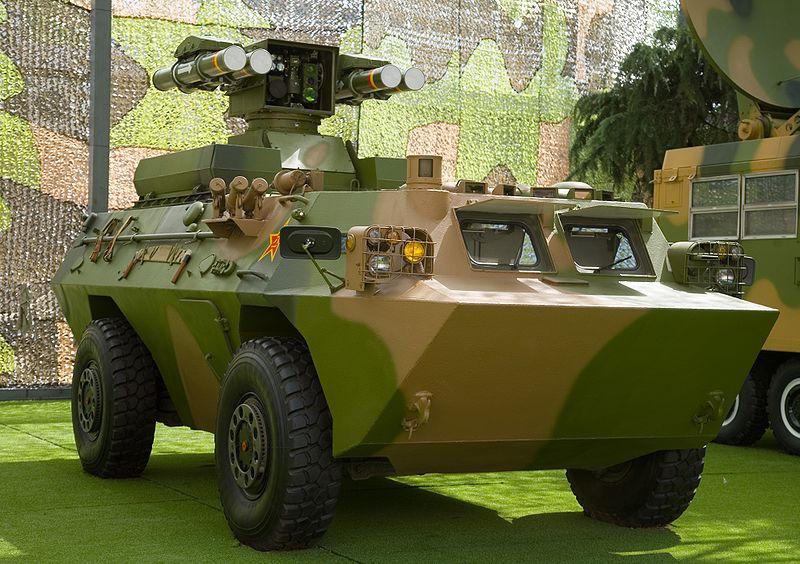

The AFT-9 was a sub-product of the WZ-550 4x4 chassis, sharing many automotive components with other vehicles in Chinese service. It shared also the same hull, less the rear axle. The armour shame and general layout was the same, with a center left engine compartment, front cab, and rear combat compartment. The crew of three comprises a commander, driver and gunner, one turned towards a station to operate the missiles.
The HongJian-9 had the entire rear section above the rear axle occupied by a retractable missile launcher, central arms and two sets of twin launching tubes. The optical and guidance systems were located in pafrt in the launcher (middle) and at the commander's sight forward. In addition to the two ready two HJ-9 missiles on either arm, there were two reloads in sdide containers for an automatioc reload remotelly performed.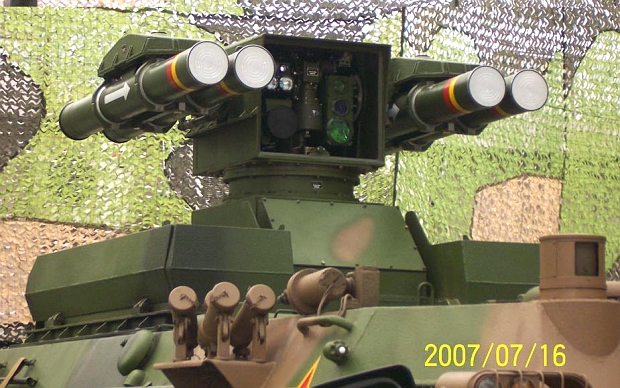
close view of the launcher
The armament of the vehicle is the HongJian 9 launcher and reload system all located at the rear. The anti-tank guided missile has four missiles ready to launch in canisters, plus an additional eight carried inside, including two in the bins below the launcher arms. The ATGM is tailored to carry a HEAT warhead capable of penetrating up to 1.200mm RHA equivalent, and thus to to engage and destroy modern MBTs.
The missiles uses an optical tracker with a single channel. So the vehicle could only fire one missile at a time. Maximum range is 5 km (3.2 miles or 18,000 ft), minimum engagement range 100 meters (110 yd or 330 ft) as reported. Variants of the HJ-9 missile could be fitted with additional warhead capable of dealing with bunkers and fortifications. Apart this, the crew is down to its personal light arms.
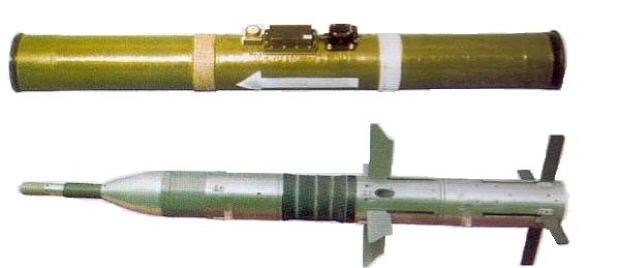
The HJ-9 missile was developed by China North Industries Corporation (Norinco) under chief designer Yang Chunming and resembles the Israeli MAPATS and South African ZT3 Ingwe. Si,ce Israeli engineers also worked on the Ingwe, there is a possible connection, with a similar guidance by laser-beam-riding. Maximum range was evaluated later as up to 5.5 km and in general the powerplant and warhead are more powerful than the HJ-8.
Like the HJ-8, the HJ-9 is usual stored in a disposable launching tube, longer and heavier in the latter case. Total weight is 37 kg (82 lb), 152 mm (6 inches) in diameter and it is said to be compatible with most thermal imaging sights. The missile is propelled by a rocker engine with solid fuel. The warhead is a tandem-charge HEAT model capable of 110–120 cm (3.6–3.9 ft) penetration RHAe, with a contact fuze. It is guided by Laser beam riding, or millimeter wave radar.
In 2005, Norinco revealed the upgraded HJ-9A, using semi-active millimetre wave radar guidance. It seems only so far deployed by Chinese paratroops using a lighweight jeep, and could be rapidly dismounted for foot soldiers to be fired in a concealed position if needed. Later a even more advanced version designated HJ-9B was aldo revealed. In all cases, the mount had a traverse of 200 degrees either side, electrically powered and elevates -10 to +10 degrees, with stabilizer.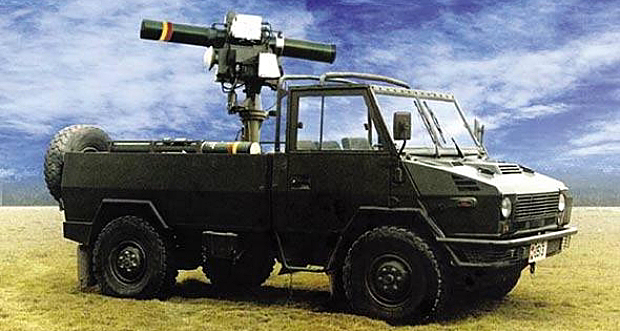
Paratropper variant using the HJ-9A
The AFT-9 so far is only in service in the People's Liberation Army of China, as main tank destroyer. Albeit it was proposed on export, none was sold so far. As of 2025 the vehicle is considered already obsolete and only efficient against older MTB models or IFs lacking active protection systems. Tactically it is lightweight however and two can be loaded in standard heavy transport jet.

Design of the AFT-9
Development
The ATF-9 development started in the early 1980s already for a light short range missile launching vehicle, partly inspired by the Soviet 9p133 Malyutka based on the 1960s BRDM-2. Or the French VAB Mephisto and VOAand completed in the late 1990s, unveiled officially in the 1999 Beijing parade. The missile generated the vehicle in many ways.Layout and General Caracteristics

The AFT-9 was a sub-product of the WZ-550 4x4 chassis, sharing many automotive components with other vehicles in Chinese service. It shared also the same hull, less the rear axle. The armour shame and general layout was the same, with a center left engine compartment, front cab, and rear combat compartment. The crew of three comprises a commander, driver and gunner, one turned towards a station to operate the missiles.
The HongJian-9 had the entire rear section above the rear axle occupied by a retractable missile launcher, central arms and two sets of twin launching tubes. The optical and guidance systems were located in pafrt in the launcher (middle) and at the commander's sight forward. In addition to the two ready two HJ-9 missiles on either arm, there were two reloads in sdide containers for an automatioc reload remotelly performed.
Protection
The platform mobility is better than the 6x6 WZ 550 vehicle, with a stand-off range determining the surviveability of its platform. The steel hull is essentally the same, but shortened, in steel RHA on a prismatic shape, with well sloped side. It protects the crew from small arms fire and shell splinters, but not much else. Access is through small triangular hatches on the low half hull forward, plus an access at the rear to reload the missiles. The latter are launched from under armor protection. In addition to the Collective NBC protection with sealing and overpressure, there is the active protyection offered by two sets of three smoke grenade launchers on either side forward, for self-defense. They could fire 75 mm or 3 inches smoke or anti-personal grenades.Propulsion & Mobility of the HongJian 9
The shortened 4x4 wheeled chassis takes advantage of a beefy engine for good mobility on and off roads, with a maximum top speed of 95 km/h on a good road, range of 600 km thanks to a Norinco turbo-charged diesel engine rated for 320 hp. Cross country mobility is reasonable for most situation but the most difficult terrain, deep mud or snow. The vehicle is fully amphibious as well, can float, cross calm water obstacles, but is not given a trim vane.Armament

close view of the launcher
The armament of the vehicle is the HongJian 9 launcher and reload system all located at the rear. The anti-tank guided missile has four missiles ready to launch in canisters, plus an additional eight carried inside, including two in the bins below the launcher arms. The ATGM is tailored to carry a HEAT warhead capable of penetrating up to 1.200mm RHA equivalent, and thus to to engage and destroy modern MBTs.
The missiles uses an optical tracker with a single channel. So the vehicle could only fire one missile at a time. Maximum range is 5 km (3.2 miles or 18,000 ft), minimum engagement range 100 meters (110 yd or 330 ft) as reported. Variants of the HJ-9 missile could be fitted with additional warhead capable of dealing with bunkers and fortifications. Apart this, the crew is down to its personal light arms.

The HJ-9 missile was developed by China North Industries Corporation (Norinco) under chief designer Yang Chunming and resembles the Israeli MAPATS and South African ZT3 Ingwe. Si,ce Israeli engineers also worked on the Ingwe, there is a possible connection, with a similar guidance by laser-beam-riding. Maximum range was evaluated later as up to 5.5 km and in general the powerplant and warhead are more powerful than the HJ-8.
Like the HJ-8, the HJ-9 is usual stored in a disposable launching tube, longer and heavier in the latter case. Total weight is 37 kg (82 lb), 152 mm (6 inches) in diameter and it is said to be compatible with most thermal imaging sights. The missile is propelled by a rocker engine with solid fuel. The warhead is a tandem-charge HEAT model capable of 110–120 cm (3.6–3.9 ft) penetration RHAe, with a contact fuze. It is guided by Laser beam riding, or millimeter wave radar.
In 2005, Norinco revealed the upgraded HJ-9A, using semi-active millimetre wave radar guidance. It seems only so far deployed by Chinese paratroops using a lighweight jeep, and could be rapidly dismounted for foot soldiers to be fired in a concealed position if needed. Later a even more advanced version designated HJ-9B was aldo revealed. In all cases, the mount had a traverse of 200 degrees either side, electrically powered and elevates -10 to +10 degrees, with stabilizer.
Production and Variants

Paratropper variant using the HJ-9A
The AFT-9 so far is only in service in the People's Liberation Army of China, as main tank destroyer. Albeit it was proposed on export, none was sold so far. As of 2025 the vehicle is considered already obsolete and only efficient against older MTB models or IFs lacking active protection systems. Tactically it is lightweight however and two can be loaded in standard heavy transport jet.
HT-9 specifications | |
| Dimensions | 6.05 x 2.8 m |
| Weight | 13.7 t combat load |
| Crew | 3 (commander, driver, gunner) |
| Propulsion | TB diesel 320 hp |
| Suspension | 4x4 shock absorbers |
| Speed | 95 km/h on road, 4.5 km/h afloat |
| Range | 600 km |
| Armament | Quad launcher, HJ-9 laser ATGM (12) |
| Protection | Steel+ NBC system, 2x4 75mm smoke grenade dischargers |
| Total production | 550 |
Gallery
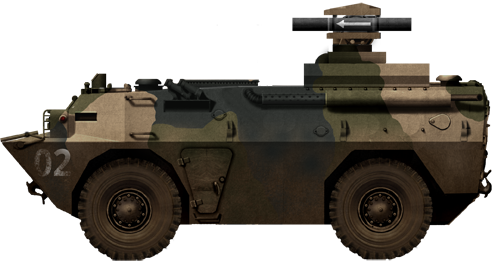
ATF-9 with initial camouflage 1999.
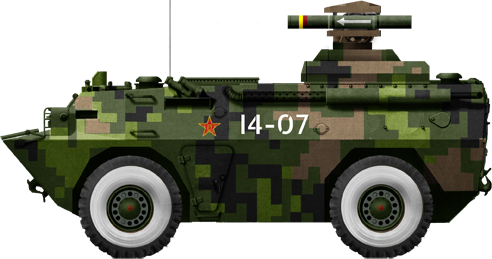
ATF-9 in parade 2008


HJ9 Missile (namuwiki src below)
Links/Src
links
weaponsystems.neten.missilery.info
en.people.cn
eng.chinamil.com.cn
seesaawiki.jp
armyrecognition.com
en.namu.wiki
AFT-9 HJ-9 anti-tank missile launcher wheeled armoured vehicle PLA China Chinese Army Recognition 1999 parade footage
On scalehobbyist.com
Video
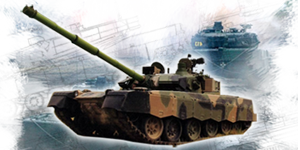
Modern Tanks
Modern MBTs posters

Denel Bagder (2018)
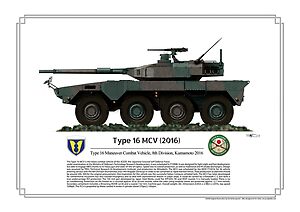
Type 16 MCV (2016)

Gepard 1A2 last rounds 2011

SANDF

Russian AFVs

Main Battle Tanks
